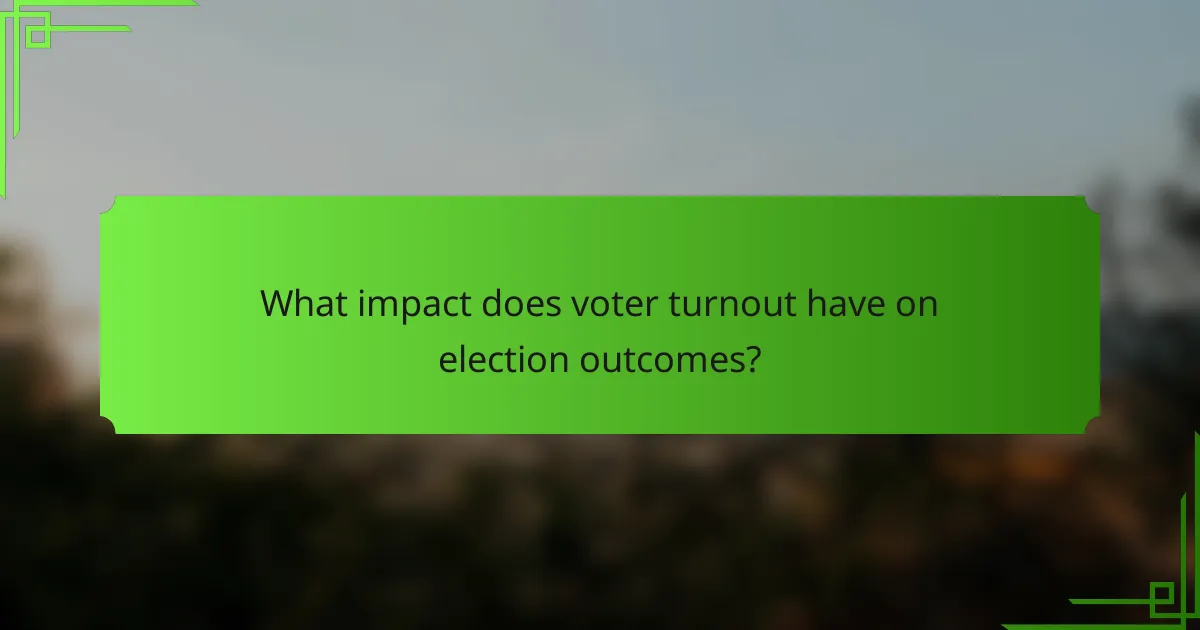Effective campaign messaging plays a crucial role in enhancing voter turnout, particularly in swing states where elections can be decided by narrow margins. By focusing on the unique concerns and values of local electorates, campaigns can foster greater engagement and participation, ultimately influencing election outcomes. States like Pennsylvania, Florida, and Wisconsin exemplify the importance of targeted communication strategies in mobilizing voters and shaping the political landscape.

How can campaign messaging increase voter turnout in swing states?
Campaign messaging can significantly boost voter turnout in swing states by resonating with the specific concerns and values of the electorate. Tailored communication strategies that address local issues and engage voters directly can lead to higher participation rates during elections.
Targeted messaging strategies
Targeted messaging involves crafting campaign messages that speak directly to the unique demographics and concerns of swing state voters. This can include focusing on local economic issues, healthcare access, or education policies that matter most to residents. By using data analytics to identify key voter segments, campaigns can tailor their messages to resonate more effectively.
For example, a campaign might highlight job creation initiatives in a state with high unemployment rates, using testimonials from local workers to strengthen the message. This approach not only informs voters but also builds a connection that encourages them to participate in the electoral process.
Use of social media platforms
Social media platforms are essential tools for reaching voters in swing states, allowing campaigns to disseminate messages quickly and interactively. Campaigns can use targeted ads on platforms like Facebook and Instagram to reach specific demographics based on interests, location, and voting history. This targeted approach can increase engagement and motivate users to share content with their networks.
Additionally, campaigns can utilize live streams and Q&A sessions to address voter concerns directly, creating a sense of community and involvement. Engaging content, such as infographics or short videos, can also make complex issues more accessible and shareable.
Community engagement initiatives
Community engagement initiatives are vital for fostering a sense of ownership among voters in swing states. Campaigns can organize town halls, community forums, and volunteer events that invite direct participation from residents. These initiatives not only inform voters about the campaign’s platform but also encourage discussions about local issues that matter to them.
Moreover, partnering with local organizations can amplify outreach efforts. For instance, collaborating with community leaders or advocacy groups can help build trust and credibility, making it more likely that residents will turn out to vote. Engaging with voters in their own environments can lead to a more informed electorate and higher turnout rates.

What impact does voter turnout have on election outcomes?
Voter turnout significantly influences election outcomes by determining which candidates and policies gain support. Higher turnout often favors certain demographics and can shift the balance of power in tight races.
Correlation with election results
There is a strong correlation between voter turnout and election results, particularly in competitive races. When turnout is high, it typically reflects greater engagement among specific voter groups, which can lead to unexpected victories for candidates who resonate with those demographics.
For instance, in swing states like Pennsylvania and Wisconsin, increased turnout among young voters or minority groups can sway election results. Historical data shows that even a few percentage points increase in turnout can change the outcome in closely contested elections.
Influence on policy decisions
Voter turnout directly influences policy decisions as elected officials respond to the preferences of those who participate in elections. When certain groups consistently show up to vote, their interests are more likely to be prioritized in legislative agendas.
For example, if environmental voters increase their turnout significantly, policymakers may feel pressured to address climate change more aggressively. Conversely, low turnout among key demographics can lead to policies that overlook their needs, reinforcing the importance of participation in shaping governance.

Which swing states are critical for voter turnout?
Critical swing states for voter turnout include Pennsylvania, Florida, and Wisconsin. These states often determine the outcome of elections due to their fluctuating voting patterns and diverse electorates.
Pennsylvania’s electoral significance
Pennsylvania plays a pivotal role in presidential elections, often swinging between Democratic and Republican candidates. Its large population and mix of urban and rural areas contribute to its electoral weight.
Voter turnout in Pennsylvania can be influenced by factors such as local issues, economic conditions, and the effectiveness of campaign messaging. Engaging with both urban centers like Philadelphia and rural communities is essential for maximizing turnout.
Florida’s diverse electorate
Florida’s electorate is notably diverse, with significant populations of Hispanic, African American, and older voters. This diversity means that campaign strategies must be tailored to address the unique concerns of different demographic groups.
High voter turnout in Florida often hinges on mobilizing these diverse communities, particularly in key regions like Miami-Dade and Orlando. Campaigns should focus on issues such as healthcare, immigration, and economic opportunity to resonate with voters.
Wisconsin’s historical trends
Wisconsin has a history of fluctuating between parties, making it a key battleground state. Factors such as labor issues, agricultural concerns, and urban-rural divides significantly impact voter turnout.
Recent elections have shown that mobilizing younger voters and addressing local economic issues can sway results in Wisconsin. Campaigns should prioritize grassroots efforts and community engagement to enhance voter participation.

What messaging frameworks are effective for mobilizing voters?
Effective messaging frameworks for mobilizing voters focus on emotional resonance and data-driven insights. These approaches can significantly enhance voter turnout by connecting with individuals on a personal level and providing them with compelling reasons to participate in elections.
Emotional appeal techniques
Emotional appeal techniques leverage feelings such as hope, fear, and pride to motivate voters. Campaigns often use storytelling to illustrate how policies impact real lives, making the message relatable and urgent. For example, sharing personal stories from constituents can create a strong emotional connection that encourages voter engagement.
Additionally, visuals and impactful language can amplify emotional responses. Using imagery that evokes community and belonging can foster a sense of responsibility among voters. Campaigns should aim to create messages that resonate emotionally while remaining authentic and respectful.
Data-driven messaging approaches
Data-driven messaging approaches utilize analytics to tailor communications to specific voter demographics and preferences. By analyzing past voting behavior and demographic data, campaigns can identify key issues that resonate with different groups. This targeted messaging can increase the likelihood of voter turnout by addressing the specific concerns of each demographic.
Moreover, incorporating statistics and facts into messaging can enhance credibility. Campaigns should present clear, concise data that supports their positions, such as polling results or economic impacts. However, it’s crucial to ensure that the data is relevant and presented in an easily digestible format to avoid overwhelming potential voters.

How do demographics affect campaign messaging strategies?
Demographics significantly influence campaign messaging strategies by determining how messages resonate with different voter groups. Tailoring communication to specific age, racial, and ethnic demographics can enhance engagement and increase voter turnout.
Age group targeting
Age group targeting is essential for effective campaign messaging, as different age demographics have distinct values and communication preferences. For instance, younger voters may respond better to digital platforms and social media, while older voters might prefer traditional media like television and print.
Campaigns should consider the issues that matter most to each age group. For example, younger voters often prioritize climate change and education, while older voters may focus on healthcare and retirement benefits. Crafting messages that align with these priorities can improve outreach efforts.
Racial and ethnic considerations
Racial and ethnic considerations are crucial in shaping campaign messaging, as these groups often have unique experiences and concerns. Understanding cultural nuances can help campaigns create messages that resonate more deeply with diverse communities.
For example, campaigns targeting Hispanic voters might emphasize immigration reform and community support, while those aimed at Black voters could focus on social justice and economic equity. Utilizing culturally relevant language and imagery can enhance relatability and foster trust among these demographics.

What role does media play in shaping voter perceptions?
Media plays a crucial role in shaping voter perceptions by influencing how information is presented and interpreted. Through various platforms, media can highlight specific issues, frame narratives, and impact public opinion, ultimately affecting voter turnout and decisions.
Influence of local news coverage
Local news coverage significantly affects voter perceptions by focusing on community-specific issues and candidates. When local media emphasizes particular topics, such as education or public safety, it can sway public opinion and mobilize voters around those concerns.
For instance, a local news outlet might report extensively on a mayoral candidate’s stance on affordable housing, which could resonate more with voters than national issues. This localized focus often leads to higher engagement and turnout in local elections.
Impact of national media narratives
National media narratives shape voter perceptions by framing broader political contexts and issues. These narratives often highlight key themes, such as economic performance or social justice, which can influence how voters perceive candidates and their platforms.
For example, if national media outlets consistently portray a political party as ineffective in handling economic issues, voters may be less likely to support candidates from that party. Understanding these narratives can help campaigns tailor their messaging to counteract negative perceptions and resonate with voters’ concerns.

How can campaigns assess the effectiveness of their messaging?
Campaigns can assess the effectiveness of their messaging through various methods, including polling, surveys, and analysis of voter turnout data. These tools help gauge public perception and the impact of specific messages on different demographics.
Polling and surveys
Polling and surveys are essential tools for campaigns to measure the effectiveness of their messaging. By gathering data on voter opinions and preferences, campaigns can identify which messages resonate most with their target audiences.
When conducting polls, campaigns should consider the timing, sample size, and methodology to ensure accurate results. A well-designed survey can reveal insights into voter motivations, concerns, and the likelihood of turnout.
For practical application, campaigns can use online survey platforms to reach a broad audience quickly. Additionally, tracking changes in polling data over time can help assess the impact of messaging adjustments and refine strategies accordingly.
